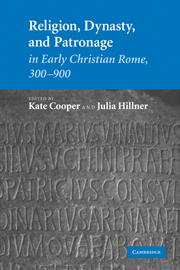Book contents
- Frontmatter
- Contents
- Acknowledgements
- List of contributors
- Abbreviations
- Introduction
- PART I ICONS OF AUTHORITY: POPE AND EMPEROR
- PART II LAY, CLERICAL, AND ASCETIC CONTEXTS FOR THE ROMAN GESTA MARTYRUM
- PART III RELIGION, DYNASTY, AND PATRONAGE
- 6 Poverty, obligation, and inheritance: Roman heiresses and the varieties of senatorial Christianity in fifth-century Rome
- 7 Demetrias ancilla dei: Anicia Demetrias and the problem of the missing patron
- 8 Families, patronage, and the titular churches of Rome, c. 300–c. 600
- 9 To be the neighbour of St Stephen: patronage, martyr cult, and Roman monasteries, c. 600–c. 900
- Bibliography
- Index
8 - Families, patronage, and the titular churches of Rome, c. 300–c. 600
Published online by Cambridge University Press: 02 October 2009
- Frontmatter
- Contents
- Acknowledgements
- List of contributors
- Abbreviations
- Introduction
- PART I ICONS OF AUTHORITY: POPE AND EMPEROR
- PART II LAY, CLERICAL, AND ASCETIC CONTEXTS FOR THE ROMAN GESTA MARTYRUM
- PART III RELIGION, DYNASTY, AND PATRONAGE
- 6 Poverty, obligation, and inheritance: Roman heiresses and the varieties of senatorial Christianity in fifth-century Rome
- 7 Demetrias ancilla dei: Anicia Demetrias and the problem of the missing patron
- 8 Families, patronage, and the titular churches of Rome, c. 300–c. 600
- 9 To be the neighbour of St Stephen: patronage, martyr cult, and Roman monasteries, c. 600–c. 900
- Bibliography
- Index
Summary
Lay patronage of the late antique Roman church presents us with something of an oddity. In the fourth and fifth centuries the Roman church was preparing itself to become one of the most powerful and richest dioceses in the western Roman empire, while in its midst resided the proud members of an extremely wealthy senatorial aristocracy, who were slowly, but inevitably, converting to Christianity. The assumption of interdependency between the two phenomena suggests itself. Yet, for most of the period we have little evidence of where the Roman church got its money from and how far the senatorial aristocracy were involved. In fact, altogether we know of only twelve fairly securely attested interventions by Roman aristocrats on behalf of Roman churches for the fourth and the fifth centuries from the epigraphic and literary evidence.
Yet, there is one particular type of church foundation in the city of Rome that is often and extensively cited not only to show the involvement of the Roman aristocracy in this matter, but also to provide insight into the legal details of their patronage. In a famous subscription list at a synod held in Rome in 499 the Roman presbyters appear as attached to twenty-nine churches distinguished by the term titulus and a personal name in the genitive (for example titulus Caeciliae). It is usually assumed that these personal names were for the most part the original founders’ names.
- Type
- Chapter
- Information
- Publisher: Cambridge University PressPrint publication year: 2007
- 6
- Cited by



